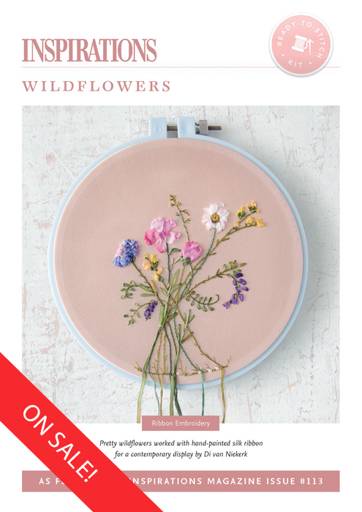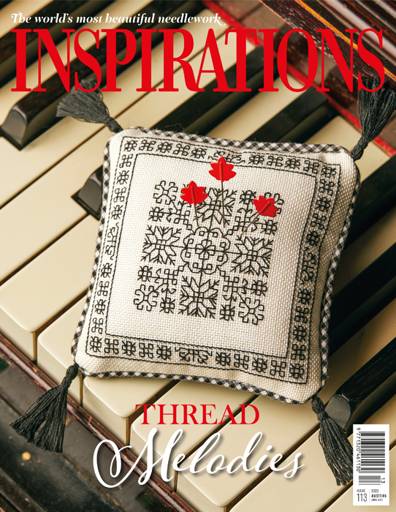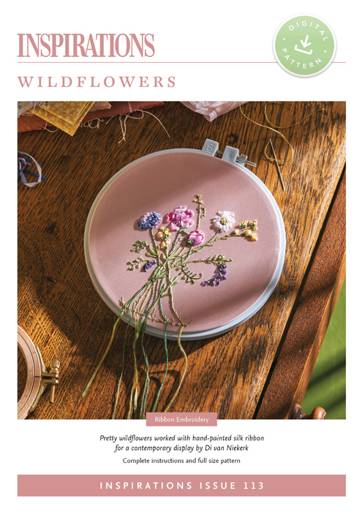Wildflowers by Di van Niekerk
4TH MARCH 2022 - ASU #320
Ribbon embroidery enjoyed its initial heyday in the sixteenth century in Europe, where French noblewomen used it to embellish their stunning day wear, evening dresses and ball gowns with elaborate silk ribbon flowers and designs. The technique was taken across the English Channel to become a favourite of English ladies, where its practice continued for several centuries.

During the more austere part of the early twentieth century, ribbon embroidery didn’t completely disappear. However, the difficulty of sourcing silk ribbon and the practical nature of much of the needlework at the time meant that the technique went quiet for a while. It began appearing again in books and magazines in the late 1970s.
It became all the rage in the 1980s and early 1990s as the love of vintage style, feminine decoration and all things floral and lacy really hit a high.
Many stitchers of today fell in love with ribbon embroidery at the time. Like everything, fashions come and go sometimes making it harder to find new designs for something you really love, simply because the world has changed.

Fortunately, ribbon embroidery has always been there, even if it hasn’t dominated the books and magazines like it once did. Now, the ribbon embroidery projects we bring you use the same delicate, traditional techniques but are more modern and simply gorgeous.
Whether you are one of the people who never tried ribbon embroidery before, or you’re a seasoned ribbon embroiderer, Di van Niekerk’s project in Inspirations issue #113 is the perfect project to tackle. It introduces you to the fundamentals of the technique, allowing you to try out a range of ribbon embroidery stitches or practice what you already know in a new and different way.

It is also a project that exemplifies the style of the twenty-first century absolutely perfectly; modern without being stark, whilst also beautiful without excessive flounce!
In order to get the most pleasure out of working Wildflowers, we recommend using pure silk ribbon.
It is glorious to stitch with, soft to the touch and sits perfectly on the fabric.
Stitching with ribbon is just as easy as stitching with thread. Once you have secured the ribbon into the needle in a special way specific to the medium, you’ll have no difficulties at all forming the petals and stalks of this lovely study.
 Double Ribbon Stitch
Double Ribbon Stitch
Di provides wonderful examples of how to do each stitch, but there is freedom in the process. You don’t have to get each stitch to look exactly like Di’s example, something that accords with the variation shown in nature. The twist and turn of the ribbon may vary each stitch, but that is as it should be. The result will be a bouquet uniquely your own, alive with colour and texture.

Wildflowers is the perfect project to start your ribbon embroidery journey. Or, if you have ever lamented the lack of ribbon embroidery projects available, it will be exactly what you have been looking for to get your hand back in to this lovely, historic technique.
Whether you mount the finished study in a hoop as Di suggests, or you mount it in another way, Wildflowers will be a project to be proud of and hopefully the start of more glorious ribbon embroidery projects to follow.
Make Your Own Wildflowers

Step 1 – Purchase Project Instructions
Wildflowers by Di van Niekerk is a pretty posy worked with hand-painted silk ribbon for a contemporary display.
Step 2 – Purchase Ready-To-Stitch Kit
The Inspirations Ready-To-Stitch kit for Wildflowers includes everything* you need to re-create this lustrous posy: Fabric (unprinted), felt, ribbons, embroidery threads and needles.

Kit
Wildflowers - i113 Kit
Shop Now*Please Note: To cater for flexibility of purchase, instructions are not included with our kits. For step-by-step directions on how to create this project, please refer to the magazine/digital pattern.


